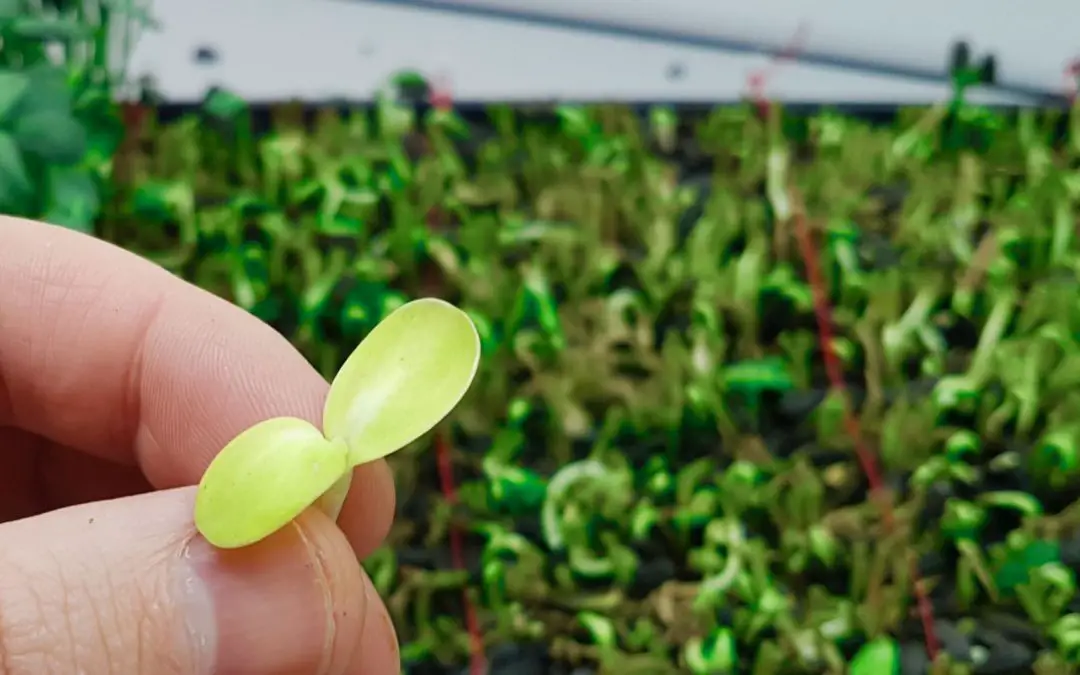The tale of the Yellow microgreen that never turned green
Once upon a time…
Okay, enough of that.
I noticed that there was a sunflower microgreens sprout in one of my trays that never turned green after the blackout period. I thought maybe it was just slow, but it grew to a normal size and all the way up to harvest it stayed yellow.
So, it got me thinking about the color of microgreens.
Why are microgreens usually green?
Microgreens are green because of the chlorophylls in the leaves and the way they absorb and reflect light. To understand where the green color comes from, we have to start with white light. White light (or the slightly yellowish light) that comes from the sun is made up all the different wavelengths of visible light (and more in the infrared and ultraviolet spectrum).
Chlorophylls absorb light from the sun, but not all of the colors. Chlorophyll preferentially absorbs blue and red light. Which, if you look at a rainbow, leaves grene in the middle. That’s the basic principle behind why microgreens are green. They reflect green light, which makes it to our eyes.
Why do my seedlings look yellow?
This is a tricky one, because there are so many different things that cause yellowing.
If seedlings are turning yellow it could be a from a few different things, but chances are it’s from too much, or too little light. Seedlings are so young, that many of the usual causes of turning yellow don’t likely apply. These are fertilizer, poor soil quality, aging leaves, lack of water, too much water, nutrient deficiencies, root damage including compacted roots, or soil pH.
For seedlings to turn yellow it could be a number of these issues. The yellowing is called Chlorosis, from a lack of chlorophylls.
When some plants have too much light, they can react by producing less chlorophyll, they just don’t need it. And because it’s the chlorophyll that gives plants the green color, they appear more yellow. This is the case with some variegated pothos and something I’ve observed personally.
It can also be because of too little light. Most seedlings turn green in response to light.
Can a yellow leaf turn green again?
The answer to this depends on the source of the yellowing. Some yellowing is reversible and some isn’t.
Older leaves will be shed naturally by plants, and when they do this, they turn yellow. This isn’t reversible. Usually once a plant stops supporting older leaves, the decision is irreversible.
Yellow leaves can also be because of infections. Some virii and other pathogens cause leaves to turn yellow by interfering with the biological function of the leaf. This type of yellowing is definitely not reversible (and it’s rare to run into this in seedlings or microgreens).
Over-exposure to the sun, or other bright light sources can cause yellowing as well. This is more of a response by the leaf to the over-abundance of light. I’ve seen leaves return to a healthy green after being moved to a less bright light source.
And for nutrient deficiency-caused yellowing, it really depends. Some nutrients are locked into the leaves when they grow, and other nutrients are mobile, able to move around the plant and replenish leaves. If the yellowing is due to a mobile nutrient, then it’s potentially reversible, otherwise it’s probably not.
For a deeper discussion of the causes of leaf yellowing check out this article:
Should I cut the yellow leaves off of my Orchid? (links to article)
Microgreens that are supposed to be yellow
Not all microgreens are supposed to be green. Some microgreens are bred to have wonderful colors. For some the stems are a different colors, or the leaves are multicolored, or for some, the whole thing is yellow.
Yellow popcorn shoot microgreens are an example of this. Yellow popcorn shoots are young corn kernels that have been sprouted, without exposing them to light. If you harvest them before they see light they stay a golden yellow color, and have a great sweet taste. Technically they’re shoots and not microgreens, but that’s splitting hairs.
Yellow Beet Microgreens are another example of microgreens that are supposed to be (partly) yellow. The stems and veins grow yellow, even with bright green leaves.
Growing more colorful varieties of microgreens is a great way to add more visual appeal and make your dishes more interesting.
Restaurants and high end resorts are particularly fond of the more colorful microgreens. So consider adding some color to your microgreen mixes. They’re easy to grow at home too.

I’m Alex Lafreniere. I learned a lot about plants when I built and operated a landscaping company. I learned even more when I started growing and selling Microgreens. But, learning is a journey, not a goal. Ever since travelling across the world, I’ve wanted to find ways to bring more delicious and exotic plants into my life. This is the site where I share everything I’ve learned with you. And maybe we’ll learn a thing or two together.
This site is owned and operated by Plant Hardware, a sole proprietor headquartered in Calgary, Canada. Plant Hardware is a participant in the Amazon Services LLC Associates Program, an affiliate advertising program designed to provide a means for sites to earn advertising fees by advertising and linking to Amazon.com. Plant Hardware may also participate in affiliate programs with Bluehost, Clickbank, CJ, ShareASale, and other sites. Plant Hardware is compensated for referring traffic and business to these companies.

